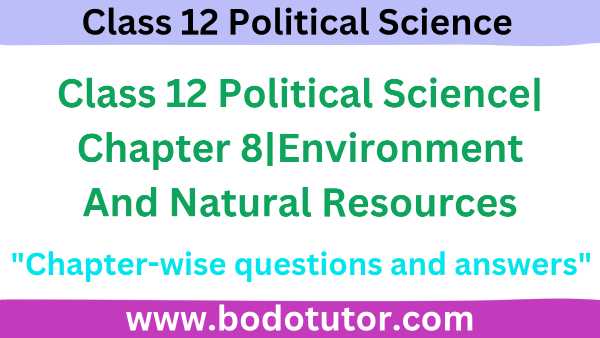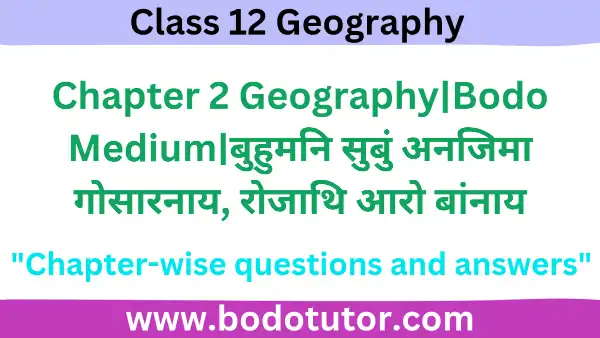Class 12 Political Science|Chapter 8|Environment And Natural Resources: Welcome to bodotutor.com ! Here you will get complete Class 12 Political Science notes based on the AHSEC|ASSEB syllabus. We are starting with Chapter 8 – Security in the Contemporary World, and we’ll continue to provide clear, easy-to-understand notes for every chapter to help you in your exams. Stay connected for regular updates and more study materials!

Class 12 Political Science|Chapter 8|Environment And Natural Resources
VERY SHORT ANSWER
Q.1. Write the full form of UNEP.
Ans: The full form of UNEP is – United Nations Environment Programme.
Q.2. What is Earth Summit?
Ans: Earth Summit was a conference on environment and development held in Rio-de Janeiro (Brazil) in June 1992. The Summit produced conventions dealing with climatic changes biodiversity forest and recommended a list of development practices called Agenda 21.
Q.3. Fill in the blank: The first world is generally referred to as the__
Ans: The first world is generally referred to as the Global North.
Q.4. When did India sign and ratify the Kyoto Protocol?
Ans: India signed and ratified the Kyoto Protocol in August 2002.
Q.5. Write ‘yes’ or ‘no’. Rio Summit recommended a list of development practices called ‘Agenda 21’.
Ans: Yes.
Q.6. What is meant by Greenhouse gas emission?
Ans: Greenhouse gas emission refers to the emission of harmful gas during the industrialization period that is believed to be causing today’s global warming and climate change.
Q.7. Write the full form of UNFCCC.
Ans: The full form of UNFCCC is United Nations Framework Convention on Climate Change.
Q.8. In which year the World Council of Indigenous People was formed?
Ans: The World Council of Indigenous People was formed in 1975.
Q.9. Write the full form of UNFCCC.
Ans: The full form of UNFCCC is United Nations Framework Convention on Climate Change.
Q.10. Which day is celebrated as Environmental Awareness Day?
Ans: Environmental Awareness Day is celebrated on 5th June.
Q.11. What is Agenda 21?
Ans: ‘Agenda 21’ is the most important outcome of Earth Summit “Agenda 21”. It suggests a list of development practices for the protection of environment.
Q.12. Why is it necessary to enact Environmental laws?
Ans: Environmental laws should be enacted for the protection of environment.
Q.13. How many states attended Earth Summit of 1992?
Ans: 170 States attended in Earth Summit of 1992.
Q.14. In which year the UN Framework Convention on Climate Change was held?Ans: In 1992, the UN Framework Convention on Climate Change was held.
VERT SHORT ANSWER
Q.1 Why was India exempted from requirements of the Kyoto Protocol?
Ans: India and China were exempted from signing Kyoto Protocol because their contribution to the emission of greenhouse gases during the industrialization period – that is believed to be causing today’s global warming and climate changes – was not significant.
Q.2. Give two examples of global commons.
Ans: Two examples of global commons are: Antarctica and the ocean floor.
Q.3. Do you think that cooperation over the Global commons is not easy. Why?
Ans: Yes, cooperation over the Global commons is not easy because there have been many path-breaking agreements such as:
(i) Antarctic Treaty – 1959
(ii) Montreal Protocol – 1987
(iii) Anarchic Environmental Protocol – 1991.
Q.4. Mention the names of two gases which are considered to be responsible for global warming.
Ans: Carbon-di-oxide and Methane are the gases which are considered to be responsible for global warming.
Q.5. Write the UN definition of indigenous people.
Ans: The UN defines indigenous population as comprising the descendants of people who inhabited the present territory of a country at the time when person of a different culture or ethnic origin arrived there from other parts of the world and overcame them.
Q.6. What is meant by resource geo-politics?
Ans: Resource geopolitics is all about who gets what, when, where and how. Resources have provided some of the key means and motives of global European power expansion.
Q.7. Environmental issues have become a matter of serious concern in global politics. Why?
Ans: Environmental issues have become a matter of serious concern in global politics because of the growing focus on environmental issues within the area of global politics was firmly consolidated at the United Nations Conference on Environment and Development. The different conventions like Brundtland Report, Rio Summit, Kyoto Protocol discuss about this issue.
Q.8. Write two causes of water pollution.
Ans: Two causes of water pollution are:
(i) Water is polluted due to garbage dumping.
(ii) Water is polluted due to bathing and washing in the river side.
Q.9. Write two issues relating to environmental degradation.
Ans: Issue of natural disaster, issue of landslide, earthquake are related to environmental degradation.
Q.10. What is the main issue of indigenous people?
Ans: The main issues of indigenous people are issues of environment, resources and politics together.
Q.11. Why are India and China exempted from Kyoto Protocol?
Ans: India and China are exempted from Kyoto Protocol because their contributions to the emission of greenhouse gases during industrialisation were insignificant.
Q.12. Give the significance of Earth Summit.
Ans: Earth Summit was held in Rio de Janeiro in 1992 for making development eco-friendly. It suggested for sustainable development, eco-friendly technology as a saviour of environment and effectiveness of regulatory provisions for environmental protection.
Q.13. Give the concept of resource geopolitics.
Ans: Resource geopolitics is all about who gets what, when, where and how. Resources have provided some of the key means and motives of global European power expansion.
Q.14. Fill in the blanks:
(a) The large part of earth is …… than the …….
Ans: Water, Soil.
(b) In India scheduled …… are ……
Ans: Tribes, Indigenous people.
(c) The second world summit on sustainable ….. was held at ….. in September.
Ans: Development, Rio.
Q.15. What is Marine and coastal degradation?
Ans:
Marine degradation: The ocean’s resources are not inexhaustible or indestructible. The number of fish species are declining as they are being overfished. Whales are no longer being hunted as they used to be but their numbers are still low. The ocean cannot keep absorbing all the waste that humans put into it. Rivers carry thousands of tonnes of fertilizer and pesticides into the ocean each year. This pollution kills fish, mangroves and coral reefs. Storm water drains deposit rubbish such as plastic bags and fertilizers into the ocean. Thousands of turtles, seals and fish are choked by plastic bags each year. Other pollutants are regularly spilled into the ocean through shipping accidents or around oil drilling rigs. Some countries regularly dump poisonous chemicals into the ocean because it is cheaper than burning them on land.
Coastal degradation: Many beaches around the world are polluted by industrial and household waste. Rubbish of all kinds such as plastic bags, drink cans and bottles end up on beaches. Many factories have been built along the coast so that they can dump their waste directly into the ocean. Botany Bay in Sydney is now heavily contaminated with lead, mercury and pesticides from factories.
LONG ANSWER
Q.1. Discuss the role of UNO in consolidating environmental issues within the arena of global politics.
Ans: International organisation like UNO plays important role in holding international conferences and promoting detailed studies to get a more coordinated and effective response to global problems. Since then, the environment has emerged as a significant issue of global politics. The growing focus on environmental issues within the arena of global politics was firmly consolidated at the United Nations Conference on Environment and Development held in Rio-de-Janeiro, Brazil in June 1992. This was also called the Earth Summit. In 1992 United Nations Framework Convention on Climate Change (UNFCCC) was also another step for UNO on Climate Change. UNO has also declared 5th June as World Environment Day. Many path-breaking agreements like Antarctic Treaty, Montreal Protocol, Anarchic Environmental Protocol etc.
Q.2. What is meant by ‘Global Commons’? Suggest two steps for protection of global commons.
Ans: The regions of the world which are located outside the sovereign jurisdiction of any one state, hence, require governance by the international community are termed as ‘Global Commons’. They cover the earth’s atmosphere, Antarctica, the ocean floor and outer space.
Following are the steps for the protection of Global Commons:
(i) Antarctic Treaty in 1959.
(ii) Montreal Protocol in 1987.
(iii) Anarchic Environmental Protocol – 1991.
Q.3. What were the outcomes of Rio Summit?
Ans: United Nations Conference on Environment and Development was held in Rio de Janeiro, Brazil in 1992. This was also a different environment agenda than the developed and developing countries of the third world. Whereas the developed countries were concerned with ozone depletion and global warming, the developing countries were anxious to address the relationship between economic development and environmental management. The Rio Summit produced conventions dealing with climate change, biodiversity, forestry and recommended a list of development practices called ‘Agenda 21’.
But it sought consensus on combining economic growth and ecological responsibility. This approach to development is commonly known as ‘Sustainable Development’. Some critics have pointed out that Agenda 21 was biased in favour of economic growth rather than ensuring ecological conservation. The relevant part of Rio Declaration says that states shall cooperate in the spirit of global partnership to conserve, protect and restore the health and integrity of the Earth’s ecosystem.
Q.4. ‘Issues related to the rights of indigenous people have been neglected for very long’ – mention some measures which have been taken to protect the rights of indigenous people.
Ans: The indigenous people are small in population. There are only a few indigenous people left out in this world. Therefore their protection is must. The following ways can be used for the protection of indigenous people:
(i) The indigenous people across the world must unite together and fight for their rights which are denied to them. The indigenous people can voice their call for equal admission to their rights in the world community of equals. They must struggle and speak for their rights.
(ii) The United Nations Organisation must work as a ward to restore the rights of indigenous people. The member nations must voice their protest to protect the indigenous people.
(iii) It is seen that the government for development includes the land of indigenous people. Hence the government must take due care that their habitation and identity is not in crisis.
(iv) Indigenous people can also be protected when their nations keep adequate provisions in their constitution to protect as well as safeguard these people. They must also be given the opportunity to get brightened amongst the majorities.
Q.5. What is meant by resource geopolitics? Mention two resources which are relevant for global politics.
Ans: Resource geopolitics is the global geographical political affairs which is concerned with the allocation and distribution of natural resources among the nation states of the global arena.
The two resources which are relevant for global politics are:
(i) Oil.
(ii) Water.
Q.6. Find out more about Kyoto Protocol. Which major countries did not sign it? And why?
Ans: The Kyoto Protocol is an international agreement setting targets for industrialized countries to cut their greenhouse gas emission. India and China were exempted from signing Kyoto Protocol because their contribution to the emission of greenhouse gases during the industrialisation period that is believed to be causing today’s global warming and climate changes was not significant.
Q.7. What are greenhouse gases? What are their effects?
Ans: Same as Ans of Q. No. 4 (Very Long Answer).
Q.8. How can common property be sold?
Ans: Common property represents common property for the group. The underlying norm here is that members of the group have both rights and duties with respect to the nature, levels of use and maintenance of a given resource.
Q.9. Write major problems of ecological issues.
Ans: Environmental concern in global politics is a very serious issue. This concern is based on the following facts:
(i) Cultivable area of the world is decreasing and a substantial part of existing agricultural land is losing fertility.
(ii) Global coastal pollution has increased. Though the open sea is comparatively clean, due to land-based activities the coastal waters are less polluted. If the intensive human settlement on coastal areas goes unchecked it would deteriorate the quality of marine environment.
(iii) Rapid decline in the total amount of ozone in the stratosphere or ozone layer endangers our ecosystem and human health.
(iv) Fisheries have been over-harvested and grasslands have been affected adversely by overgrazing.
(v) Water bodies due to pollution are suffering depletion leading to reduction of food grain production.
(vi) Natural forests which are essential for stabilizing climate, moderating water supplies and harbouring majority of earth’s biodiversity on land have been cut resulting in displacement of people. Loss of diversity has led to deforestation.
Q.10. Explain the concept of water wars with examples.
Ans: Regional variations in the increasing scarcity of fresh water in some parts of the world point to the possibility of disagreements over shared water resources as a leading source of conflicts in the 21st century. Some commentators of world politics have referred to ‘water wars’ to describe the possibility of violent conflict over this life-sustaining resource.
Q.11. Write a note on UN’s definition and rights of indigenous peoples.
Ans: The UN defines indigenous population as comprising the descendants of people who inhabited the present territory of a country at the time when persons of a different culture or ethnic origin arrived there from other parts of the world and overcame them.
Q.12. What are different perspectives for which the rich and the poor countries agree to protect the Earth?
Ans: India and China’s relationship has been destroyed due to following points–
(a) Border Issue: The boundary dispute between India and China is long-standing. The borderline i.e. the McMohan Line was not accepted by the Chinese who referred to it as the imperialist line. China made illegal claims to about 1,28,000 square kilometres of Indian territory in NEFA, now Arunachal Pradesh and in the Aksai Chin area of the Ladakh sector.
(b) Nuclear Tests: India conducted the first nuclear test in 1974 which was highly condemned by China and became a cause of tension between India and China. The second test in 1998 at Pokhran was also disliked by China and stated that the test conducted by India will threaten the similar nations of Asia.
(c) China’s assistance to Pakistan: Chinese help to Pakistan especially during the two wars of 1965 and 1971 threatened India’s security. China provided all help during the wars to defeat India. During the 1965 war they accused India of criminal aggression and in 1971 of interference in the internal affairs of Pakistan.
(d) Tibetan issue: Tibetan issue started in 1950 when China launched a full-scale invasion of Tibet. India protested against this and China accused India of being influenced by imperial powers. However the revolt was put down by the Chinese in 1959. The spiritual and political leader, Dalai Lama along with thousands of refugees fled to India.
Q.13. Write short notes on:
(a) Land degradation.
Ans: Throughout the area cultivable work is barely expanding anymore. A substantial portion of existing agricultural land is losing its fertility. Natural forests are reduced. River erosion is taking place.
(b) Pollution and Climate change.
Ans: Pollution is a big problem now which has badly affected the climate. There are industrial pollutions, especially man-made pollution has affected our climate. Climate change poses serious threat to the earth.
(c) Global Warming.
Ans: Global Warming is the rise in global temperature which may have catastrophic consequences for life on earth.
VERY LONG ANSWER
Q.1. Write a brief note on India’s stand on environmental issues.
Ans: The Indian Government is already participating in global efforts through a number of programmes.
(i) India’s national auto fuel policy mandates cleaner fuels for vehicles.
(ii) The Energy Conservation Act, passed in 2001, outlines initiatives to improve energy efficiency.
(iii) The Electricity Act of 2003 and the use of renewable energy.
(iv) Recent trends in import of natural gas and encouraging the adoption of clean coal technologies so that India has been taking real efforts.
(v) Government is also keen to launch a National Mission on Biodiesel using about 11 million hectares of land to produce biodiesel by 2011 to 2012.
(vi) India has one of the largest renewable energy programmes in the world.
Q.2. What is meant by ‘Common but differentiated responsibilities’?
Ans: The Rio Summit declaration says that states shall cooperate in the spirit of global partnership to conserve, protect and restore the health and integrity of Earth’s ecosystem. In view of the different contribution of global environmental degradation, states have common but differentiated responsibilities.
The developed countries acknowledge the responsibility that they bear in the international pursuit of sustainable development in view of the pressures their societies place on the global environment and the technological and financial resources they command. In 1992, ‘United Nations Framework Convention on Climate Change’ (UNFCCC) also provides that the parties should act to protect the climate system “on the basis of equity and in accordance with their common but differentiated responsibilities and respective capabilities.” The parties to the convention agreed that the largest share of historical and current global emissions of greenhouse gases has originated in the developed countries. It was also agreed that per capita emissions in developing countries like India and China are still relatively low. Thus, India, China and other developing countries were, therefore, exempted from the requirements of Kyoto Protocol.
The Kyoto Protocol is an international agreement setting targets for industrialized countries to cut their greenhouse gas emissions. Certain gases like carbon dioxide, methane etc. are considered responsible for global warming – the rise of global temperature which may have dangerous consequences for life on earth. Thus, the underlying norm is that developing and developed countries have both rights and duties with respect to the nature, levels of use and the maintenance of given resources.
Q.3. What is the significance of oil and water in global politics?
Ans: Oil continues to be the most important resource in global strategy. The global economy relied on oil for much of the 20th century as a portable and indispensable fuel. The immense wealth associated with oil generates political struggles to control it. The history of petroleum is also the history of war and struggle.
Out of the total oil reserves of the world, the Gulf region accounts for 30% of the global oil production. But it has about 64% of the planet’s known reserves and is therefore, the only region able to satisfy any substantial rise in oil demand. Saudi Arabia has a quarter of the world’s total reserves and is the single largest producer. Iraq’s known reserves are second only to Saudi Arabia’s. And since substantial portions of Iraqi territory are yet to be fully explored, there is a fair chance that actual reserves might be far larger. The United States, Europe, Japan and increasingly India and China which consume the petroleum are located at a considerable distance from the region.
Water is a crucial resource that is relevant to politics. Regional variations and the increasing scarcity of freshwater in some parts of the world point to the possibility of disagreements over shared water resources as a leading source of conflicts in the 21st century.
Some proponents have predicted the possibility of a violent war over this life-sustaining resource. States sharing river water can dispute over downstream pollution, excessive irrigation or construction of dams in the upstream of the river which might degrade the quality of water available to the downstream state. States can use force to protect or seize freshwater resources.
For example, to illustrate, the dispute between Israel, Syria and Jordan over the Jordan and Yarmuk Rivers is a well-known water dispute. India and China are also fighting hard over construction of a dam on river Brahmaputra which will hamper the flow of water to India. More recently, the dispute between Turkey, Syria and Iraq over building of a dam over Euphrates river exemplified water wars.
Q.4. Write a short note on common property resources.
Ans: Common property represents common property for the group. The underlying norm here is that members of the group have both rights and duties with respect to the nature, levels of use, and the maintenance of a given resource. Through mutual understanding and centuries of practice, many village communities in India, for example, have defined members’ rights and responsibilities.
A combination of factors, including privatization, agricultural intensification, population growth and ecosystem degradation have caused common property to dwindle in size, quality and availability to the poor in much of the world. The institutional arrangements for the actual management of the sacred groves on state or forest land appropriately fit the description of a common property regime. Along the forest belt of South India, sacred groves have been traditionally managed by village communities.
Q.5. Mention some of the programmes through which the Indian government is participating in global efforts against global warming or emission of pollutants.
Ans: The Indian Government is already participating in global efforts through a number of programmes.
(i) India’s national auto fuel policy mandates cleaner fuels for vehicles.
(ii) The Energy Conservation Act, passed in 2001, outlines initiatives to improve energy efficiency.
(iii) The Electricity Act of 2003 and the use of renewable energy.
(iv) Recent trends in import of natural gas and encouraging the adoption of clean coal technologies so that India has been taking real efforts.
(v) Government is also keen to launch a National Mission on Biodiesel using about 11 million hectares of land to produce biodiesel by 2011 to 2012.
(vi) India has one of the largest renewable energy programmes in the world.
Q.6. “The consciousness about environmental hazards has become a matter of great concern these days” – Elucidate with appropriate example.
Ans: Environmental issues have become a matter of serious concern in global politics because of the growing focus on environmental issues within the area of global politics was firmly consolidated at the United Nations Conference on Environment and Development. The different conventions like Brundtland Report, Rio Summit, Kyoto Protocol discussed about this issue.
Q.7. What is Kyoto Protocol? Explain.
Ans: Same as Ans of Q. No. 6 (Long Answer).
Q.8. Write about the protection of global commons.
Ans: The regions of the world which are located outside the sovereign jurisdiction of any state, hence, require common governance by the international community are termed as ‘Global Commons’. They cover the earth’s atmosphere, Antarctica, the ocean floor and outer space.
Following are the steps for the protection of Global Commons:
(i) Antarctic Treaty in 1959.
(ii) Montreal Protocol, 1987.
(iii) Anarchic Environmental Protocol – 1991.
Q.9. Explain UNFCCC.
Ans: UNFCCC means United Nations Framework Convention on Climate Change. The first Summit was held in 1992 which was a big step by UNO on climate change.




